Victoria Square, named after Princess Victoria (later Queen Victoria) in 1836, is the central and most significant of Adelaide’s squares. Due to the importance placed on the Square by the Council and people of Adelaide, it has seen, and continues to see, numerous redevelopments, alterations, redesigns and planting schemes, designed to improve both its appearance and usability.
Pre-Contact History
The City of Adelaide is located on the Kaurna people’s land of Tarndayangga, place of the Red Kangaroo dreaming, with Victoria Square located on, or near to, the central camp of the Tarndanya clan. European colonisation would cause a dramatic disruption to this population, causing people to move away and for the population to decline due to disease, violence and migration and segregation into settlements and missions.
Post-Contact Planning and Establishment of Victoria Square
Following European settlement Colonel William Light and his team of surveyors drew up a plan for the colony’s capital, which soon began to be imposed on the landscape. The area where Victoria Square is located was marked out and left largely as it was, while the land around it began to be developed into the City of Adelaide.
The purpose that Colonel William Light had for Victoria Square, however, was still up for debate in the mid-nineteenth century. Bishop Augustus Short, South Australia’s first Anglican Bishop, claimed that Light intended the Square as a place for public worship, to build a cathedral on the acre of land he owned in the southern section of the Square in 1855. He based his claim on a 1838 plan of Victoria Square by Colonel William Light that had a small illustration of a church in its southern section. The Corporation of Adelaide, however, disagreed, arguing that the space was for public purposes not just those of the Anglican Church. The Bishop took the Corporation to the Supreme Court to pursue his aim of building the church. The Court made their decision on 29 June 1855, declaring that the Square was set apart as a recreational space for the inhabitants of Adelaide and not for any religious purposes, ending the Bishop’s claim to the land in Victoria Square.
Design Alterations and Planting Schemes
Victoria Square saw numerous design alterations and planting schemes throughout its history. The first of which would be implemented by George Francis (later the first director of the Adelaide Botanical Garden) in 1854. Francis, having won the tender put out by the City Corporation for the planting of the city squares, proposed his planting scheme. His plan involved the planting of acacia, almond, olive, gum, poplar and cypress trees in the city squares, three-thousand of which were planted in Victoria Square.
Another planting scheme was later implemented following the appointment of William O’Brien to the position of City Gardener in 1865. He selected a series of ornamental trees to be planted in the city squares, including Norfolk Island pines, Moreton Bay figs, white cedars, Kurrajongs and cassia trees. O’Brien also gravelled the paths and erected iron palisade fencing. Victoria Square, however, was not fenced due to the extension of King William Street through the Square. The extension, completed in 1883, dissected the Square into four quadrants, each later enclosed with iron palisade fencing.
Despite all of these works and plantings, the condition of Victoria Square was steadily deteriorating in the late nineteenth century. The City Corporation established a special committee in 1897 to investigate the management and condition of the city squares. Following site inspections, the committee recommended the removal of 24 trees from Victoria Square as well as the appointment of a gardener for each of the squares. This would markedly improve their appearance.;
Another significant contribution to the improved condition of the Square was the work of the newly appointed City Gardener August Wilhelm Pelzer, who was given the position in 1899. Pelzer began by reseeding the lawns with couch grass and removing trees from the center of the flower beds in Victoria Square, replacing them with palm trees. He also placed hoop fencing around the lawns to stop people from walking through them. Pelzer, however, was not finished with these beautification measures, also planning to decrease the number of trees in each of the squares. He removed large numbers of trees, specifically targeting pine, Moreton Bay fig and pepper trees, to allow more light and air through the Square. Pelzer continued to take measures to improve and maintain the appearance of the squares, such as the removal or replacement of trees, the redesigning and replanting of flower beds and the removal of fencing, throughout his time as City Gardener, a position he occupied until his retirement in 1932.
Significance to Indigenous Peoples
Following the Second World War, the population of Indigenous peoples in the City increased. This was due to a change in policy and community attitudes from one of segregation to one of assimilation. A mix of groups, including Kaurna, Narungga and Ngarrindjeri peoples, began migrating or returning to the City from missions. These people saw a chance to improve their lives due to the better access to good education and jobs in the City. They, however, were unable to become assimilated into the social life of Adelaide, instead creating their own social networks and places. Open spaces, such as the city squares, became important as places where people could gather, socialise, discuss and resolve disputes.
Victoria Square, located in the centre of the City away from the west end where Indigenous peoples lived, had a different purpose to the other squares. Light and Whitmore Squares, located in the west end of the city, attracted more family groups and was used mainly as a recreational space. From the 1960s Victoria Square, on the other hand, was used as a place to await court appearances and to attend to personal matters. In the 1970s Victoria Square was used for social and political purposes, with the Square becoming a popular place for public social movements to assemble. It was in Victoria Square that the Australian Aboriginal Flag was first unfurled at a National Aborigines Day Observance Committee (NADOC now NAIDOC) celebration on 12 July 1971 and was, and continues to be, where the annual National Aborigines and Islanders Day Observance Committee (NAIDOC) march begins. As well as these events, Victoria Square has been where Indigenous peoples from both the City and from rural areas of the state have met to campaign for social justice. For instance, it was where Pitjantjatjara Elders discussed their case before meeting with Premier Don Dunstan about their Native Title claim (which they were awarded in July 1978).
Victoria Square has since continued to be used as a gathering place and still holds significance to Indigenous peoples due to its history and continued use. To acknowledge the significance of the Square to Indigenous peoples, the City Corporation proposed to dual name Victoria Square with a Kaurna name. After calling for suggestions, the Corporation eventually chose the name Tarntanyangga, meaning red kangaroo rock place after the Red Kangaroo Dreaming. In 2002 the Square was officially given the dual name of Tarntanyangga/ Victoria Square to acknowledge the Indigenous connection to the Square and its significance to the Kaurna people. The Aboriginal flag also now flies permanently next to the Australian flag in the Square.
Statues of Victoria Square
Various statues and monuments have also been placed in Victoria Square throughout its history, becoming prominent features of its landscape.
Farnese Hurcules
The statue of Hercules, unveiled in 1892, was the first statue in Victoria Square. It was gifted to the city by William Austin Horn, who acquired it in Europe. the statue depicts Hercules as a heavily muscled man with a heavy club and lion skin cloak, a copy of the Farnese Hercules by the Athenian sculptor Glykon that was excavated in the sixteenth century. Glykon, who worked as a copyist in Roman times, copied an earlier fourth century BC statue of Hercules by the Greek sculptor Lyssipus. It was located in Victoria Square, surrounded by railings and a garden, until it was moved in 1930 to Pennington Gardens in North Adelaide.
Queen Victoria
The statue of Queen Victoria stands prominently in the centre of Adelaide and the square that bears her name, at the junction of Grote and Wakefield Street. The life-sized bronze statue stands on an elaborate pedestal that reads ‘Victoria RI’. The Queen is depicted as the stern matriarch of the British Empire, heavily robed, holding the royal sceptre and orb crowned by a tiara. It was made in an England foundry from a model by Charles Bell Birch, who specialised in portrait busts of politicians and the gentry. It was commissioned by Sir Edwin Thomas Smith, who as mayor in the prosperous 1880s championed the improvement and beautification of the city. The statue was unveiled to a large crowd on 11 August 1894.
John McDouall Stuart
The statue of John McDouall Stuart was unveiled 4 june 1904. Stuart led the first successful European expedition through the centre of Australia in 1862. His triumphant return to Adelaide coincided with the mournful procession of Burke and Wills remains through Adelaide in January 1863. Despite this, crowds lined North Terrace to welcome Stuart’s return on 21 January.
Although, he returned to England and died on 5 June 1866, he was still remembered in Adelaide where a movement to erect a monument soon began. Following the anniversary of his expedition in 1895, funds began to be collected for a monument. Local sculptor William Maxwell was selected, but he died before he could carve the imported Italian Carrara marble he chose for the monument. James White, a Scottish sculptor from Sydney would finish the work.
The monument depicts Stuart dressed in his bush clothes, with a Union Jack draped over his left shoulder. In his right hand is his journal, while his helmet, saddle and sextant are scattered on the ground around him. The unveiling drew a large crowd and such was the regard in which people held Stuart, an even larger one came to see the monument the following day.
Colonel William Light
The statue to Colonel William Light, the Surveyor-General and planner of the city of Adelaide, was unveiled in Victoria Square on 27 November 1906. The idea for the statue came from the committee in charge of organising a replacement for his memorial in Light Square, who decided that a statue of Light should also be built. The design by Scottish sculptor Birnie Rhind was chosen. Rhind depicted Light in his full military uniform with one hand holding a map, while his right arm is extended out, pointing off into the distance in front of him. It was placed at the King William Street intersection with the statue pointing down the busy street. This would soon become problematic, however, as it soon became a traffic hazard. Complaints and appeals to move the statue began in 1908, but it was not until 1936 that it was moved to its current location on Montefiore Hill.
Charles Cameron Kingston
The statue of Charles Cameron Kingston was unveiled to a large crowd on 26 May 1916. Kingston was Premier of South Australia for six years, overseeing the introduction of women’s suffrage and the Federation of Australia. The movement to erect the statue was started by Sir Samuel Way and heavily supported by Kingston’s friends Sir John Langdon Bonython and William Denny. Alfred Drury was chosen as the sculptor for the work. Kingston is depicted in full ceremonial garb, including a sword, frock coat and gaiters. He is positioned in a oratorical pose with his right hand raised. The pedestal on which the statue stands is elaborately carved with bronze relief panels on three sides.
Captain Charles Sturt
The statue of Captain Charles Sturt was unveiled 21 December 1916. Sturt, although only spending twelve years of his life in South Australia, was always held in high regard by South Australians. He was an explorer, launching numerous expeditions from both Adelaide and Sydney, and was the first European to explore and chart the Murrumbidgee-Murray-Darling river system. The idea of building a statue to Sturt began at the turn of the nineteenth and twentieth centuries when monuments to the ‘founding fathers’ of South Australia were being built. The design by Captain Adrian Jones was eventually chosen, much to the delight of Sturt’s daughter, Charlotte Sturt, who supported Jones’ design.
Jones depicted Sturt in an open-necked shirt, thick bush pants and a broad brimmed hat. In his left hand he holds a telescope and a map, with his right hand he shields his eyes from the sun while gazing at the eastern horizon. The animated pose of the statue sets it out in contrast to the other monuments erected in Victoria Square.
Recent Development of Victoria Square
Victoria Square would see further redevelopments after the Second World War. First the Square had to be restored, air raid shelters that were dug during the war were filled and the top soil and lawns relaid. These works also included a plan for a central fountain in Victoria Square. This plan, however, would not be realised until the later redevelopment of the Square in the 1960s.
Beginning in 1965, this redevelopment would see King William Street rearranged so that it was diverted around the centre of the Victoria Square instead of running through it. A fountain was commissioned by the City Corporation in 1968 and placed in the centre of the northern section of the Square. Named The Three Rivers, the fountain was created by Adelaide born artist John Dowie. His design took inspiration from the Murray, Torrens and Onkaparinga rivers that feed the fountain as each is represented by a human figure and a bird (a women with a black swan represents the Torrens, a women with a heron for the Onkaparinga and an Aboriginal man with an ibis for the Murray). These aluminium figures adorn each of the three sides of the fountain.
Completed in 1969, the redevelopment did little to appease the Corporation, with an advisory committee established by Lord Mayor Robert Porter in November 1968. This committee was to advise upon the principles that further redevelopments of Victoria Square would adhere to and to investigate and report on the appearance of the buildings fronting the Square. Professor Denis Winston was then commissioned in 1969 to design further redevelopment plans for the Square based upon the committee’s principles. Although not fully enacted, Winston’s plan did provide inspiration for future plans and continued the community debate and discussion of the configuration and purpose of Victoria Square.
The debate continued through the 1970s, 1980s and 1990s with several different plans being proposed. Lord Mayor Bowen proposed the ‘Bowen Beautification Plan’ in 1978, which included putting the Grote-Wakefield Street traffic route, which cut through the Square, underground. Proposals and ideas continued to be made in the 1980s, with one proposal suggesting an underground tramway, while another plan by landscape architect Christopher Degenhardt proposed the building of mounds in the Square. In February 1992 architect Michael Thiele proposed the removal of all roads, the construction of an observation tower, a three story underground carpark and an underground theatre. However, none of these proposals were accepted by the City Corporation.
The City Council eventually endorsed a major renovation of the Square in 2012. Stage one of the project, which involved the relocation of The Three Rivers fountain to the southern side of the Square and the transformation of the northern section into an event space with a raised performance area, covered seating, a water fountain, new lawn and the planting of one hundred gum trees, was completed in 2014. Stage two, however, has yet to be financed, putting the rest of the redevelopment on hold.


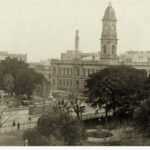

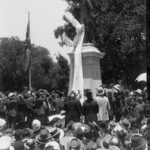
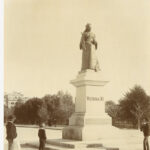
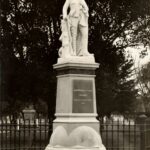
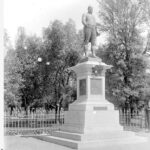
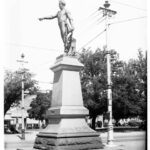
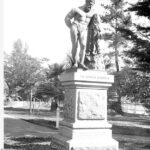
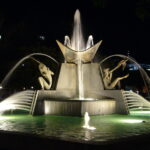
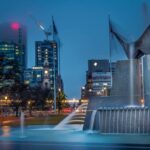
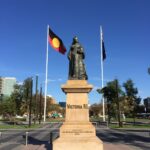
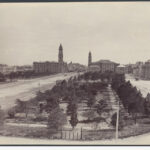
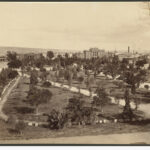
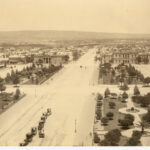
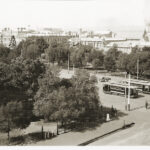
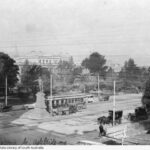
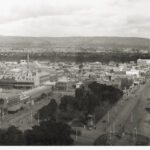
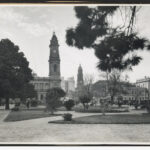
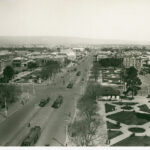
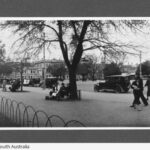
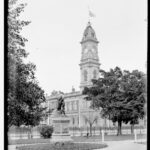
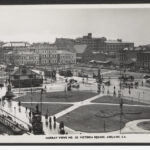


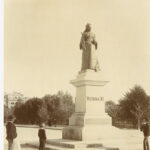
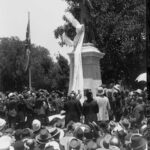
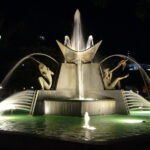
Comments